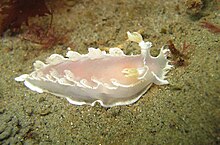Tritoniidae is a taxonomic family of nudibranchs in the suborder Cladobranchia, shell-less marine gastropod molluscs.[1] This family includes some of the largest known nudibranchs, with the NE Atlantic species Tritonia hombergii reaching 20 cm in length. It is the only family in the monotypic superfamily Tritonioidea.
| Tritoniidae | |
|---|---|

| |
| A live individual of Tritonia festiva in situ | |
| Scientific classification | |
| Domain: | Eukaryota |
| Kingdom: | Animalia |
| Phylum: | Mollusca |
| Class: | Gastropoda |
| Order: | Nudibranchia |
| Suborder: | Cladobranchia |
| Superfamily: | Tritonioidea Lamarck, 1809 |
| Family: | Tritoniidae Menke, 1828 |
| Synonyms | |
| |
Distribution
editThese nudibranchs occur worldwide in warm and temperate seas and in the coldest waters and deep sea, wherever the octocorals which they eat are found.
Ecology
editMembers of the family Tritoniidae feed on octocorals, including sea pens, alcyonarian soft corals, and gorgonians, often being cryptic in shape and colouration upon them.[2] They share this trait with the Arminidae which were previously thought to be only distantly related, but have been shown to be closely related to the Tritoniidae by a recent study.[3]
Genera
editThe genera in the family Tritoniidae include:
- Duvaucelia Risso, 1826
- Marianina Pruvot-Fol, 1931
- Marionia Vayssiere, 1877
- Paratritonia Baba, 1949
- Tochuina Odhner, 1963
- Tritonia Cuvier, 1798
- Tritonicula Korshunova & Martynov, 2020
- Tritonidoxa Bergh, 1907
- Tritoniella Eliot, 1907
- Tritoniopsis Eliot, 1905
References
edit- ^ MolluscaBase (2018). Tritoniidae Lamarck, 1809. Accessed on 2021-01-01
- ^ García-Matucheski, S. and Muniain, C. (2011). Predation by the nudibranch Tritonia odhneri (Opisthobranchia:Tritoniidae) on octocorals from the South Atlantic Ocean. Marine Biodiversity, 41(2), 287–297.
- ^ Korshunova, T.; Martynov, A. (2020). Consolidated data on the phylogeny and evolution of the family Tritoniidae (Gastropoda: Nudibranchia) contribute to genera reassessment and clarify the taxonomic status of the neuroscience models Tritonia and Tochuina. PLOS ONE. 15(11): e0242103.